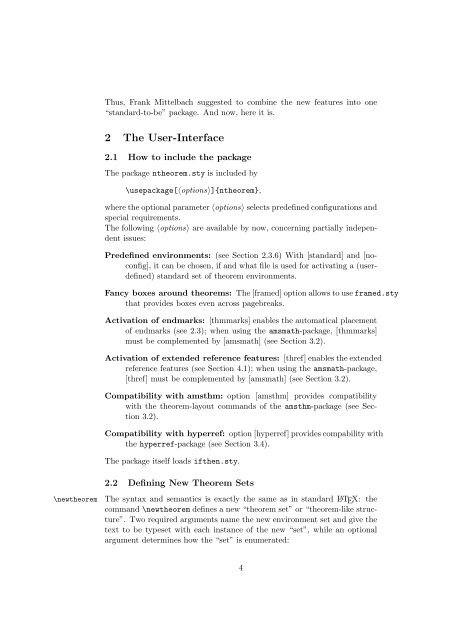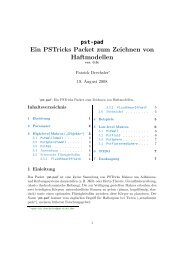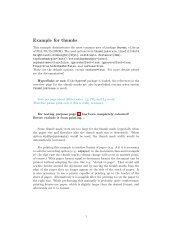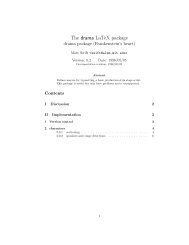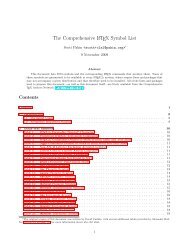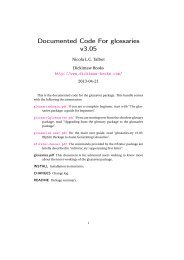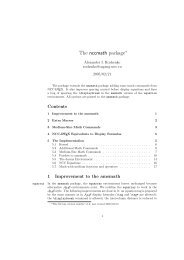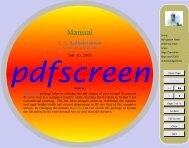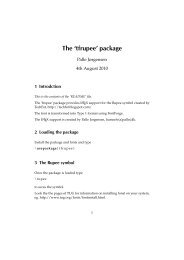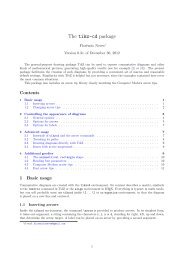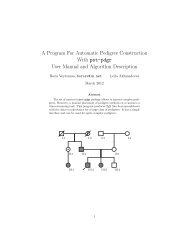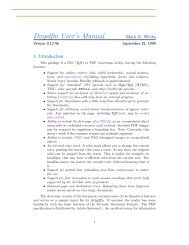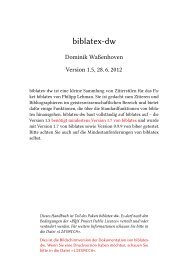ntheorem.pdf. - Mirrors.med.harvard.edu
ntheorem.pdf. - Mirrors.med.harvard.edu
ntheorem.pdf. - Mirrors.med.harvard.edu
You also want an ePaper? Increase the reach of your titles
YUMPU automatically turns print PDFs into web optimized ePapers that Google loves.
\newtheorem<br />
Thus, Frank Mittelbach suggested to combine the new features into one<br />
“standard-to-be” package. And now, here it is.<br />
2 The User-Interface<br />
2.1 How to include the package<br />
The package <strong>ntheorem</strong>.sty is included by<br />
\usepackage[〈options〉]{<strong>ntheorem</strong>},<br />
wheretheoptional parameter〈options〉 selects predefinedconfigurationsand<br />
special requirements.<br />
The following 〈options〉 are available by now, concerning partially independent<br />
issues:<br />
Predefined environments: (see Section 2.3.6) With [standard] and [noconfig],<br />
it can be chosen, if and what file is used for activating a (userdefined)<br />
standard set of theorem environments.<br />
Fancy boxes around theorems: The[fra<strong>med</strong>]optionallowstousefra<strong>med</strong>.sty<br />
that provides boxes even across pagebreaks.<br />
Activation of endmarks: [thmmarks] enables the automatical placement<br />
of endmarks (see 2.3); when using the amsmath-package, [thmmarks]<br />
must be complemented by [amsmath] (see Section 3.2).<br />
Activation of extended reference features: [thref]enablestheextended<br />
reference features (see Section 4.1); when using the amsmath-package,<br />
[thref] must be complemented by [amsmath] (see Section 3.2).<br />
Compatibility with amsthm: option [amsthm] provides compatibility<br />
with the theorem-layout commands of the amsthm-package (see Section<br />
3.2).<br />
Compatibility with hyperref: option[hyperref]providescompabilitywith<br />
the hyperref-package (see Section 3.4).<br />
The package itself loads ifthen.sty.<br />
2.2 Defining New Theorem Sets<br />
The syntax and semantics is exactly the same as in standard LATEX: the<br />
command \newtheorem defines a new “theorem set” or “theorem-like structure”.<br />
Two required arguments name the new environment set and give the<br />
text to be typeset with each instance of the new “set”, while an optional<br />
argument determines how the “set” is enumerated:<br />
4


